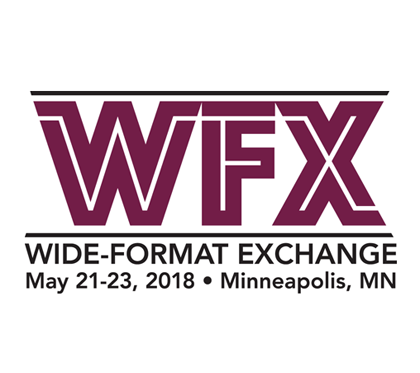Best Practices
WFX: Wide-Format Exchange in Review
Inaugural wide-format printing event was recently held in Minneapolis.
Published
6 years agoon

The inaugural WFX: Wide-Format Exchange conference was held recently in Minneapolis, uniting the brightest minds in wide-format printing at the Renaissance Minneapolis Hotel, The Depot. Co-organized by ST Media Group and the Specialty Graphics Imaging Association (SGIA), WFX served as a connection and learning sphere for high-volume, wide-format print providers and their peers. The ST staff was on the ground attending all of the keynotes, educational sessions and breakout roundtables.
Raising Your Game
The event kicked off with a keynote speech from Ryan Estis, CEO of Ryan Estis & Associates, who discussed “Breakthrough Performance in the New Economy.” Estis, a former advertising executive, implored business owners in the audience to chase reinvention and to push themselves in spite of fear of failure and/or the unknown. Estis also encouraged businesses to be hyper-aware about their customer base, claiming that consumers will change their preferences and overall scope more in the next five years than they have in the past 50. “Be different, authentic and compelling,” he said. “Give customers a little more than they expect each time.” Highlighting a desire for loyal customers over satisfied customers, Estis noted the difference between customers who would refer a company those who do.
Under One Root
In “Managing the Dynamics of Family-Held Businesses,” Greg Root, president of GMN, discussed how his family navigates running a business together. Day-to-day, the Roots have separate family meetings before board meetings to address interests specific to the family. Family bylaws govern how divorce, death, disability and retirement will be handled, along with how voting shares are controlled – and by whom. Each family member has a defined active or non-active role. “Don’t try to hang on too long; prepare an early transition,” Root said, noting he and his siblings plan to set a mandatory retirement age to prevent stagnation. “Too often, later in life, we decide, ‘I liked it the way it was,’” he said. Finally, Root said his family deals with everyday spats with one simple rule: If a family member says you need to leave, you go home. This contains blowups and preserves professionalism – necessary for handing down a healthy company to the next generation.
The Millennial Dollar Question
Print and signage providers discussed retention, Millennials and corporate culture in “Keeping Print Relevant for the Next Generation,” led by ST’s Robin Donovan. Ben King (King Signs, Graphics & Imaging), Dalton Scott (Young Professionals of Minneapolis) and Brian Adam (Olympus Group) presented some keys for keeping younger employees engaged: Create an authentic culture that has a clear purpose for them. Millennials who see how their day-to-day contributes to a team goal will work harder and stay at a company longer.
Beyond monetary compensation, flexibility is important to them, yet the signage and printing industries are hard-pressed to offer flexible schedules. Instead, Scott suggested, offer training and educational opportunities. Finally, check your ratings on glassdoor.com to ensure you’re not driving potential recruits away before the first interview. And with all these special measures in place, you should be able to recruit and retain capable employees of all generations; don’t be afraid to demand higher levels of creativity and productivity from your newly engaged workforce.
Make Green by Going Green
“Why Sustainability and Profitability Go Hand in Hand,” moderated by Marci Kinter, vice president of government and business information for SGIA, led a panel that debunked the notion that sustainable practices are necessarily more costly. Jenny Dela Cruz, COO and co-founder of Snowball Print Marketing, stated that her new company was launched with sustainability goals in mind, uses post-consumer substrates and works exclusively with Sustainable Green Printing Partnership (SGP) vendors. She feels the stumbling blocks for print customers are awareness and education.
AdvertisementMarco Ugarte, sustainability manager for MillerCoors, said that his company’s top priorities are water and energy conservation as well as carbon packaging. Through efforts such as using a grain byproduct for bottle labels and others, the company has significantly reduced its landfill waste. They also participate in recycling, partnering with another company to collect and sort glass bottles for MillerCoors to make into new ones. The company’s goal is to reduce its carbon footprint by 50%.
Scott Schulte, CEO of Modernistic, has also reduced his company’s landfill waste – by a whopping 75% – and he reminded the audience of the cost savings therein. As an SGP certified printer, Modernistic uses sustainable substrates as well as techniques to reduce material and energy use at every turn. From rightsizing cartons to reduce the need for packing peanuts, to placing adhesive only where it’s needed, Modernistic recycles nearly 333 tons of plastic and paper per year.
Snapping to Social Media
Inna Semenyuk, founder and CEO of Innavation Labs and formerly of SnapChat, led the discussion for “Leveraging the Power of Technology and Social Media to Maximize Profit.” She stated her feeling that social media should not be just about driving traffic, but rather about creating a complementary experience to a company’s product or service. She offered the example of SnapChat Snapcodes, which function like QR codes in SnapChat images. But instead of taking a user to a website, the Snapcode takes a user to exclusive, non-web page. She relayed an anecdote about a shoe company putting Snapcodes on billboards and even a basketball arena backboard, and that anyone who had SnapChat could read and use the codes. The result was the shoe company selling out of its exclusive release within its first hour available.
Women in Print
Six winners of Big Picture magazine’s annual award shared industry insights during “The Women in Print Panel.” Michelle Gobert, owner and president of Image360 Central, talked about her long work days and how they impacted her family-owned business. She expects that same hard-hitting work ethic from her kids, but also knows they need time – including a gap year, in one case – to mature and explore before joining her workforce.
The Changing World of Retail
Kraig Kessel, co-founder of Kraido, noted in “Why the Retail Store is Evolving, Not Disappearing” that while pop-up stores are changing the retail landscape, retailers expect to be opening more stores in 2018 than closing them. “The life cycles of retail are more compressed,” he said, adding that new ideas are both constantly emerging and being purchased. Other emerging trends are customers buying online but picking up in stores, and Millennials purchasing from companies that give back.
The Only Leadership Decision that Really Matters
Closing keynoter Anthony Tjan, an entrepreneur and investor who is also managing partner and CEO of Cue Ball, told the story of Miniluxe, a nail salon revolutionizing a service industry plagued by employer abuses and hygienic deficits. The shops are an outgrowth of Tjan’s dedication to employee-driven corporate cultures.
Tjan identified five mentoring questions to guide engagement:
- What is it you really want to be and do?
- What are you doing really well that is helping you get there?
- What are you not doing well that is keeping you from getting there?
- What will you do differently tomorrow to meet those challenges?
- How can I help?
And he exhorted executives to wait 24 hours before criticizing new ideas. “Spend the time thinking of every single reason an idea might work,” he said. ‘Out of the box’ doesn’t just mean a radical idea, it means actually listening.” And when you speak, watch your phrasing: “Language makes culture. Use language that makes your team proud. The biggest thing in training is to let your employees feel like entrepreneurs.”

SPONSORED VIDEO
Introducing the Sign Industry Podcast
The Sign Industry Podcast is a platform for every sign person out there — from the old-timers who bent neon and hand-lettered boats to those venturing into new technologies — we want to get their stories out for everyone to hear. Come join us and listen to stories, learn tricks or techniques, and get insights of what’s to come. We are the world’s second oldest profession. The folks who started the world’s oldest profession needed a sign.
You may like

Avery Dennison Adopts Mimaki Printer for Traffic Sign Print System

Fiery Releases SignLab 11

21 Larry Albright Plasma Globes, Crackle Tubes and More
Subscribe

Bulletins
Get the most important news and business ideas from Signs of the Times magazine's news bulletin.
Most Popular
-

 Tip Sheet3 days ago
Tip Sheet3 days agoAlways Brand Yourself and Wear Fewer Hats — Two of April’s Sign Tips
-

 Business Management1 week ago
Business Management1 week agoWhen Should Sign Companies Hire Salespeople or Fire Customers?
-

 Women in Signs2 weeks ago
Women in Signs2 weeks ago2024 Women in Signs Award Winners Excel in Diverse Roles
-

 Real Deal4 days ago
Real Deal4 days agoA Woman Sign Company Owner Confronts a Sexist Wholesaler
-

 Editor's Note1 week ago
Editor's Note1 week agoWhy We Still Need the Women in Signs Award
-

 Maggie Harlow2 weeks ago
Maggie Harlow2 weeks agoThe Surprising Value Complaints Bring to Your Sign Company
-

 Line Time2 weeks ago
Line Time2 weeks agoOne Less Thing to Do for Sign Customers
-

 Product Buying + Technology1 week ago
Product Buying + Technology1 week agoADA Signs and More Uses for Engraving Machines











